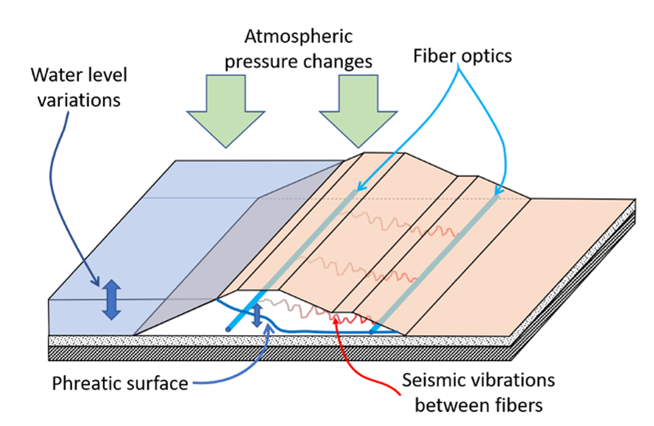Sisprobe, in collaboration with Silixa and HydroResearch offers the capability of monitoring tailings dams and other facilities in real time and in 3D. Using Distributed Acoustic Sensing (DAS) and optical fibres, we can image the entire dam and its foundations and provide immediate warning of internal degradation that may lead to dam failure.

Capability Statement – Real-Time Monitoring of Tailings Storage Facilities
“Keeping tailings facilities safe and stable is the most challenging task in the entire mining process.” (Lyu et al. 2019). On average, three of the world’s 3,500 tailings dams fail every year. The catastrophe at Vale’s Córrego do Feijao mine in January 2019 killed 237 people, left 1,000 people homeless, and cost the company $5bn.
The standard approach for real-time monitoring of tailings storage facilities employs borehole piezometers, but these point measurements are generally not sensitive to internal erosion. Monitoring of the wall surface visually or using ground- or satellite-based radar is useful but only monitors surface expressions of internal degradation.
borehole piezometers, but these point measurements are generally not sensitive to internal erosion. Monitoring of the wall surface visually or using ground- or satellite-based radar is useful but only monitors surface expressions of internal degradation.
Real-Time Monitoring
Sisprobe has developed an innovative real-time method capable of ‘seeing’ within tailings dam walls. The methodology uses proven science, contemporary hardware and innovative processing methodologies and satisfies a number of principles in ICMM’s recently published Global Industry Standard on Tailings Management. The new passive seismic method – ambient noise interferometry – is already used in mineral exploration to image seismic velocities to km depths and to monitor conditions in producing oil & gas fields.
Background vibrations have been recorded by conventional geophones – either self-contained nodes for temporary measurements or solar-powered wireless stations for permanent monitoring. Fibre-optic distributed sensors, an attractive alternative technology, can yield distributed temperature, strain and seismic data. Temperature readings are sensitive to flow channels close to the cable and strain is sensitive to local deformations. The seismic method detects and localises extremely small changes, even those caused by changing air pressures or the lunar cycle. It senses internal erosion tens of meters from the cable and produces 3D images of the dam wall.
Using optic fibre cables and a Distributed Acoustic Sensing (DAS) system, Sisprobe can monitor the entire dam wall and its foundations in real time. The system detects internal degradation with the structure and provides early warning of potential failure. Dam wall heights from a few metres to a few hundred metres can be monitored.
Using optic fibre cables and a Distributed Acoustic Sensing (DAS) system, Sisprobe can monitor the entire dam wall and its foundations in real time. The system detects internal degradation with the structure and provides early warning of potential failure. Dam wall heights from a few metres to a few hundred metres can be monitored.

